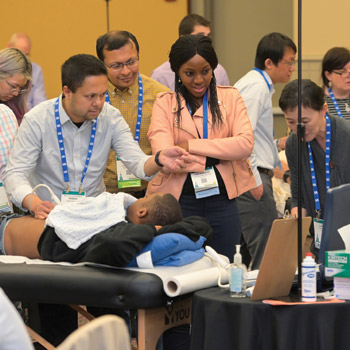4 concepts can help bolster age-friendly care
Medical groups seek to implement the 4Ms—Medication, Mentation, Mobility, and What Matters—into practice when caring for elderly adults.
It's easy to agree that older adults deserve care that addresses their particular challenges. The best way to provide such care, however, has been more of an open question.
In 2017, the John A. Hartford Foundation and the Institute for Healthcare Improvement (IHI), in partnership with the American Hospital Association and the Catholic Health Association of the United States, convened a group of patients, caregivers, health system leaders, and experts in geriatric care to work toward finding some concrete answers.

The Age-Friendly Health Systems Advisory Group identified close to 100 models that had been shown to be effective in different settings and involved dozens of different components, according to ACP Member Mary Tinetti, MD, who served as the group's co-chair. “The effective models had only modestly been scaled up … and there were just too many models to expect any health care system to do so,” she said. “So with the input from patients, clinicians, experts, and health care leadership, we came up with several that were really the core of what anybody would think of if you're providing age-friendly health care.”
Those four principles, dubbed the 4Ms—Medication, Mentation, Mobility, and What Matters—became the backbone of the IHI's Age-Friendly Health Systems initiative, said Dr. Tinetti, who is also the Gladys Phillips Crofoot Professor of Medicine (Geriatrics) and section chief of geriatrics at Yale University School of Medicine in New Haven, Conn.
She recently spoke to ACP Internist about the best ways to put these components into practice when caring for elderly adults. “The goal was to get 20% of health care systems throughout the United States becoming age-friendly by 2020,” Dr. Tinetti said. “So this is the year.”
Q: Can you expand a bit on the 4Ms and what's involved with them?
A: Medication is linked to medication reconciliation, as well as avoiding medications that are potentially harmful in older adults while focusing on those that support each patient's goals. In the hospital setting, delirium is the part of mentation that we worry about most, for which there are effective strategies. In the outpatient setting, mentation includes depression and dementia, which are very common in older adults, [for] which there are identified interventions that have not necessarily been widely disseminated. Mobility, the third M, encompasses not just fall prevention [and] safety, but also is the core of function, and function is what matters to older adults who tend to have multiple chronic conditions.
The fourth M, which is the core of all of it, is what matters most to that individual. In the face of all the tradeoffs that happen when you have multiple chronic conditions, which most older adults do, what matters most to each individual is variable. What matters most to you may differ from what matters most to me, so all care should be predicated on achieving what matters most to each individual person. That's how we went from the overarching goal of health systems being age-friendly to the way you would know if you were age-friendly. The way to get there is to assess and act on these four Ms.
Q: Are any of the 4Ms more or less likely to already be addressed in primary care?
A: In primary care, it's really in some ways a little bit of a heavier lift because primary care right now is so driven by diseases and the requirements of meeting quality metrics for blood pressure, diabetes, etc. More primary care programs, however, are adapting the Medicare Annual Wellness Visit. It makes sense for What Matters to be part of the kind of goal setting that should be part of advanced care planning during that visit. Medications are a key piece of that; function is a key piece of that.
Mobility comes [in] because fall prevention is a required part of the Annual Wellness Visit, and clinicians can take the focus just from on fall prevention to safe mobility. It's something that they're already doing that they could use to discuss the 4Ms approach. The other is medications. Medication reconciliation is extremely time-consuming and cumbersome, but if you do it through the mechanism of identifying some high-risk medications that you can then do something about, and have a framing for doing that, it makes something you already have to do more effective and hopefully more efficient as well.
We're very cognizant of the fact that for primary care, [which] already bears the brunt of the metrics and the RVU [relative value unit], etc., we didn't want this to be one more thing. We wanted this to be things you're already doing. How can it be more effective for your older patients and hopefully less burdensome for you?
Q: What are some of the other challenges involved in implementing the 4Ms?
A: I think there's the perception among some clinicians that, if you focus on the 4 Ms, your blood pressure metrics may get worse or your glucose metrics may get worse. In our experience, that's not the case because a lot of the reasons why the blood pressure metrics and the glucose metrics are not being met is because we expect so much of these individuals that they're just not adherent. If you really do align your blood pressure approach, for example, with medications that individuals are willing and able to take and avoid ones they think really are harming them … you're probably going to get more adherence, and overall your metrics are going to get better. That's No. 1.
No. 2, a lot of these metrics are no longer required, at least by CMS, for people 75 and older. Physicians can go to their health care system and say, “Listen, these blood pressure and glucose metrics are not required by CMS for this age group. Do we have to follow them so that I can really focus my time and efforts on what's appropriate for that patient?”
I think that time is always a challenge, but we don't expect any of these to be done at any one visit. This is something that's done over time. Also, the 4Ms absolutely require a team. Identifying What Matters is not something that any individual clinician can do on their own. That's something that other members of the health care team can do and probably are better qualified to do, whether it's social work or nursing or care coordination. The whole team then aligns their care with What Matters.
Q: What are some of the other benefits of this approach?
A: My own work right now is Patient Priorities Care, an approach which for older adults with multiple chronic conditions is aimed at aligning their care with what matters, their health care priorities, meaning the outcomes patients most want, given what they're willing and able to do to achieve them. What we have found in our work is it doesn't take any more encounters once you start doing it, it doesn't take any more time, but it does result in patients' feeling less burdened by their care and a reduction in unwanted care.
It also simplifies decision making. …When somebody's got 20 different diseases on 20 different medications, and they have 20 different chief complaints, where do you start? The whole concept of identifying what people want is a way to simplify that. Yale University has also worked with ACP in developing an online Patient Priorities Care curriculum for helping clinical practices identify patients' health care priorities and for training clinicians how to incorporate this into their practice.
Q: What has the reception been for the IHI initiative so far?
A: Obviously, I'm more likely to only hear the positive aspects, but I'm hearing about it everywhere. In my own health system, I'm not sure their leadership even knew that I was part of the national [4Ms] leadership, but they have bought into it lock, stock, and barrel and are using the framework to become age friendly across its six hospitals. I was asked to do a presentation to the primary care component of our health system and got a lot of really positive feedback. They raised a lot of concerns about how to do this and how to incorporate it into their already overloaded workflow, but as a way to approach the care of this population in primary care, it was very positively received.
At a national level, evidence that it's working is reports that the number of health systems that are taking on the 4Ms both in their ambulatory and their inpatient settings is increasing.
So, do we have a long way to go? Absolutely. Does everyone buy into this? By no means. But are we seeing some heightening awareness and interest? Definitely.
One other promising sign is that the 4Ms are being incorporated into the training of health care professionals, including physicians and nurses and physician assistants. We've gotten positive feedback throughout the country.
Q: What other advice would you give physicians who are interested in focusing on the 4Ms?
A: On the face of it, this looks daunting. It looks like one more thing. But I would like to caution them to suspend that appropriate skepticism and really just try it on one or two different patients. Ask, “Given everything that's going on with you now, what would you most want me to focus on in your health or your health care?” Just start there, and think of all the tools they already have, and focus their tools on what matters most to these one or two patients. I think they may be surprised. It may not be quite as overwhelming as they think.
Editor's Note: More information about the Age-Friendly Health Systems initiative is online. More information about the ACP Patient Priorities Care curriculum is online.




